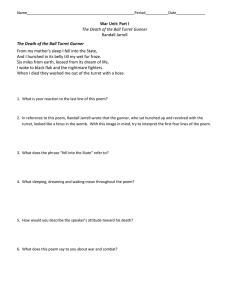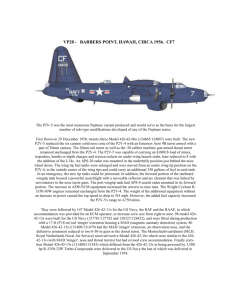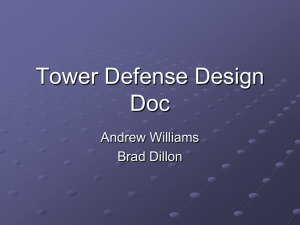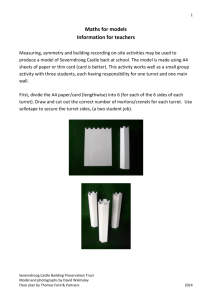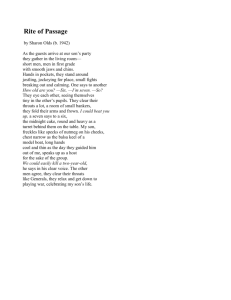Corresponding author, E-mail
advertisement
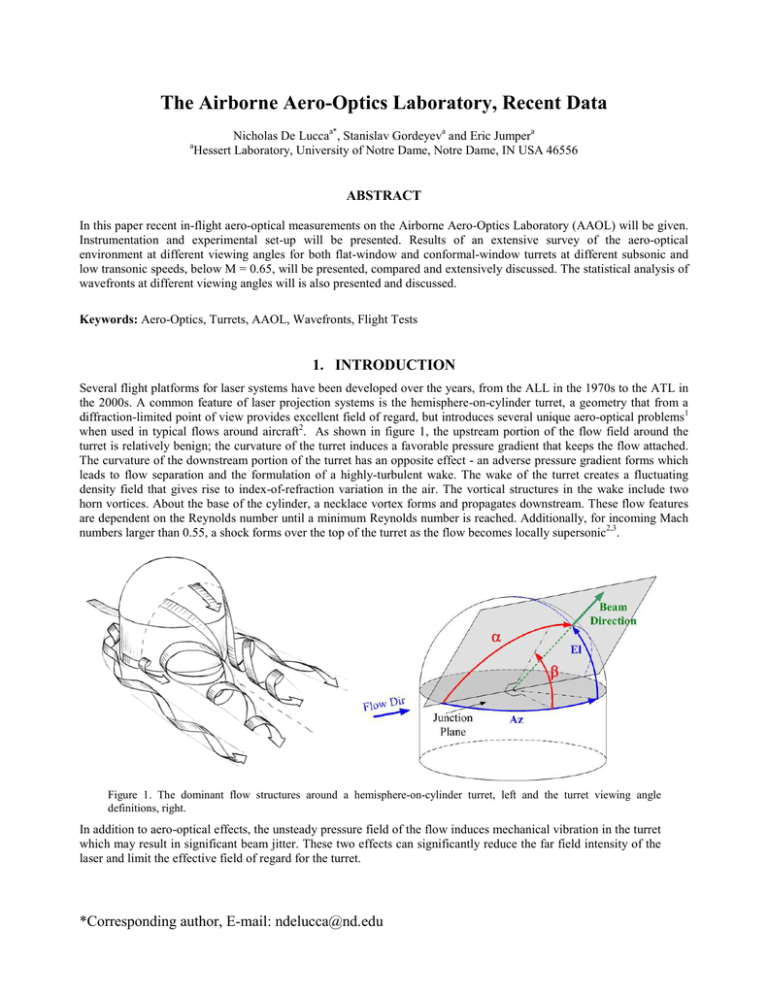
The Airborne Aero-Optics Laboratory, Recent Data Nicholas De Luccaa*, Stanislav Gordeyeva and Eric Jumpera Hessert Laboratory, University of Notre Dame, Notre Dame, IN USA 46556 a ABSTRACT In this paper recent in-flight aero-optical measurements on the Airborne Aero-Optics Laboratory (AAOL) will be given. Instrumentation and experimental set-up will be presented. Results of an extensive survey of the aero-optical environment at different viewing angles for both flat-window and conformal-window turrets at different subsonic and low transonic speeds, below M = 0.65, will be presented, compared and extensively discussed. The statistical analysis of wavefronts at different viewing angles will is also presented and discussed. Keywords: Aero-Optics, Turrets, AAOL, Wavefronts, Flight Tests 1. INTRODUCTION Several flight platforms for laser systems have been developed over the years, from the ALL in the 1970s to the ATL in the 2000s. A common feature of laser projection systems is the hemisphere-on-cylinder turret, a geometry that from a diffraction-limited point of view provides excellent field of regard, but introduces several unique aero-optical problems1 when used in typical flows around aircraft2. As shown in figure 1, the upstream portion of the flow field around the turret is relatively benign; the curvature of the turret induces a favorable pressure gradient that keeps the flow attached. The curvature of the downstream portion of the turret has an opposite effect - an adverse pressure gradient forms which leads to flow separation and the formulation of a highly-turbulent wake. The wake of the turret creates a fluctuating density field that gives rise to index-of-refraction variation in the air. The vortical structures in the wake include two horn vortices. About the base of the cylinder, a necklace vortex forms and propagates downstream. These flow features are dependent on the Reynolds number until a minimum Reynolds number is reached. Additionally, for incoming Mach numbers larger than 0.55, a shock forms over the top of the turret as the flow becomes locally supersonic2,3. Figure 1. The dominant flow structures around a hemisphere-on-cylinder turret, left and the turret viewing angle definitions, right. In addition to aero-optical effects, the unsteady pressure field of the flow induces mechanical vibration in the turret which may result in significant beam jitter. These two effects can significantly reduce the far field intensity of the laser and limit the effective field of regard for the turret. *Corresponding author, E-mail: ndelucca@nd.edu The turret viewing direction is commonly described with two angles, the azimuthal angle (Az) and the elevation angle (El). From a fluid-flow perspective, a different coordinate system helps to collapse the data and still be able to account for some elevation angle dependence. As shown in figure 1, right, the azimuth and elevation angles are transformed into two new angles, α, the viewing angle and β, the modified elevation angle. The transformation for these two angles is given by α = cos −1 (cos( Az ) cos(El )) and β = tan −1 tan (El ) . The reason for this coordinate change can be demonstrated sin ( Az ) using the turret flow field described in figure 1. For pure spheres, the flow field would only be a function of how far upstream or downstream the turret is looking, which is represented by the angle α. The modified elevation angle accounts for changes in the flow that are derived from the symmetry-breaking presence of the cylinder under the hemisphere, the aircraft wall and the existence of the horn vortices mentioned earlier. 2. EXPERIMENTAL SETUP 2.1 Instrumentation The AAOL provides a flight-test platform for studying these and other aero-optical effects and designing mitigation systems with flow control or adaptive optics. Detailed description of AAOL is provided in Jumper et al.4. Here we provide only essential details about the flight experiment. Two aircraft flying in closed formation are used in the AAOL program. The laboratory aircraft holds the turret assembly, mounted to the optical bench inside the aircraft so that it protrudes into the airstream through a modified escape hatch. The various other measurement systems can also be integrated into the escape hatch. The second aircraft flies in close formation with the laboratory aircraft; the second aircraft projects a laser beam onto the laboratory aircraft turret pupil. This source laser is projected out of a window on the source aircraft instead from a second turret, to avoid propagation through non-boundary-layer turbulence. The emitted laser projects through the attached boundary layer as a small beam aperture that is diverging so that by the time it arrives at the laboratory turret it overfills the turret pupil by two times. Because of the initial small beam size and overfill of the laboratory aircraft turret pupil, the tracking requirements for the source beam are somewhat less than that for the turret on the laboratory aircraft. Figure 2. The AAOL turret with a flat-window (left) and a comformal-winodw (rght) apertures. An annotated photograph and schematics of the optical bench on the laboratory aircraft are given in Figure 3. The primary sensor on the laboratory aircraft (AAOL) is the high-speed 2-D Shack-Hartmann wavefront sensor, capable of acquiring wavefronts with spatial resolution of 32x32 at 25 kHz. The initial 0.10 m aperture beam is re-imaged to the 0.02 m beam. Additionally, the turret assembly contains a closed-loop Fast Steering Mirror (FSM) system which stabilizes the beam on the sensor. Residual beam jitter is measured by a Position Sensing Device (PSD) on the optical table. In addition to acquiring wavefronts and the residual jitter, instantaneous flight speed, static/total pressures and the turret’s elevation and azimuth angles were recorded, along with the instantaneous distance between the two aircraft measured via differential GPS. The residual jitter data, flight parameters and turret angles were acquired simultaneously at 100 kHz. The wavefronts and GPS data were collected with separate Data Acquisition Systems at different sampling speeds, but they were synchronized with the jitter data. Although it was acquired during flight tests, the residual jitter and GPS data will not be discussed in this paper. The analysis of the jitter data can be found in the companion paper5. Figure 3. The optical setup on the turret aircraft. Data were acquired in one of two different modes: a fixed relative aircraft position or a “slew” maneuver. For fixedposition data, wavefronts were acquired at 25 kHz for 15,000 frames. Fixed position data allows collected data at higher sampling frequency for a better time resolution of aero-optical structures. A slewing maneuver involved the source laser aircraft moving slowly and monotonically with respect to the turret aircraft. To enable data acquisition for a longer time period of 7 seconds, the wavefront acquisition rate was reduced to 3 kHz for slewing maneuvers and total of 21,000 wavefronts were acquired per each slew maneuver. Wavefronts collected during slewing maneuvers, while not timeresolved, provided statistical properties of aero-optical distortions over a range of elevation/azimuthal angles and facilitate an overall mapping of the optical performance of the turret over a large field of regard. Flight conditions varied from M = 0.4 or M = 0.5 at an altitude of 15,000 ft to M = 0.6-0.65 at altitudes from 28,000-34,000 ft. 2.2 Wavefront Reduction and Analysis Processing image data from the high-speed WF sensor provides spatial-temporal-resolved wavefront sequences, W = W (x, y, t ) . For each wavefront sequence, the steady lensing, instantaneous tip/tilt and instantaneous piston were removed from each wavefront during data reduction. The procedure is slightly different for slewing maneuvers, as will be explained in more detail later in this paper. The Optical Path Difference, OPD, which is the conjugate of the wavefront, is given by OPD = −W . Several statistical quantities were calculated from these wavefront sequences. One of them is the instantaneous spatial RMS of the OPD over the aperture, OPDRMS (t ) = OPD(x, y, t ) 2 , where angle x, y brackets denote spatial averaging over the aperture. The time-averaged OPDRMS(t), later in this paper denoted by just OPDRMS, gives the overall value of aero-optical distortions at a given angle. The temporal histogram of instantaneous OPDRMS(t) provides useful information about the temporal deviation around the time-averaged OPDRMS and is also useful for checking data quality. The temporal variation of OPDRMS(t) is quantified by the spread of the OPDRMS(t), defined as Σ = (OPD (t ) − OPDRMS ) 2 RMS , which is the standard deviation of the OPDRMS over its time-averaged value. It is also useful to quantify the spatial distribution of the aero-optical distortions. This is achieved by taking the temporal RMS of the OPD of each fixed point over the aperture, OPDRMS ( x, y ) = OPD( x, y, t )2 , later referred to in this paper as the spatial distribution of OPDRMS. Before raw images from the high-speed WF sensor were converted into wavefronts, wavefront data quality was checked through several measures. The first series of checks occurs during wavefront data reduction. In Figure 4 an example of a raw image file is presented; it should be noted that this image has been image enhanced so that it is easier to view. Although the Shack-Hartmann sensor is technically intensityinvariant, the intensity of a given dot can vary in time, potentially affecting the data quality. As a result, any location on the image with sufficiently low-intensity can temporally lose enough intensity to make centroid determination inaccurate. To correct for this, dots with very low average intensity were ignored in processing. Additionally, having intensity that is too large will saturate the dot image and reduce the sub-pixel resolution for centroid determination. To avoid this issue, neutral-density filters were, if needed, added to or removed from the optical train in flight to regulate the beam intensity at the sensor. The mean flow around the turret imposes a density field that lenses the beam. This steady lensing is viewing-angle and elevation-angle dependent. Because the beam train assumes a specific aircraft separation when re-imaging, the steady lensing also has a defocus component, depending on the relative distance between the two aircraft. The strength of this defocus changes over the course of a slew maneuver as aircraft separation does not remain constant. The Figure 4. A sample image from the Shacktotal steady lensing of the beam is removed for each averaging Hartmann WF sensor. subset to compensate for both these effects. To eliminate this corrupting effect during a slew maneuver, the slew data series were split into 0.5-second subsets, and average statistics were computed over the these subset time periods; thus, the shorttime steady lensing and the instantaneous tip/tilt were removed from each 0.5 second subset. The slew rate for the aircraft, in terms of turret rotation, was typically two degrees per second, and as a result, averaging over a half second of data gave results in averaging over a single degree of rotation. Figure 5 shows the statistical convergence of OPDRMS as a function of data set duration. The OPDRMS converges within half a second, confirming that 0.5-second data sequence provides correct statistics of OPDRMS at the viewing angle. As fixed-position data were acquired at 25 kHz for 0.6 seconds, it was not subdivided and the steady lensing across all frames and instantaneous tip/tilt were removed. The full suite of statistics was computed for each fixed-angle data set and each slewing maneuver subset. Figure 5. The convergence of OPDRMS for a slew maneuver. After images from the high-speed WF sensor were converted into wavefront sequences, using commercially available software, various statistical quantities were calculated from them, as discussed earlier. Besides providing important statistical information about aero-optical distortions, these quantities give additional measures of data quality. Figure 6 gives an example of two metrics, the spatial distribution of OPDRMS and probability distribution function of the instantaneous OPDRMS. For the spatial distribution of the OPDRMS at back-looking angles, the linear gradient in the flow direction is typical of a shear layer formed over the aperture; the downstream portion of the aperture looks through a larger portion of the shear layer than the upstream part, increasing the local OPDRMS. The spatial distribution also does not contain any obvious modes such as a large defocus contribution or any single points that are vastly different from those near it. The histograms of the temporal distribution of OPDRMS typically have a log-normal distribution, as shown in Figure 6, right plot. Wavefronts with unusually-large values of OPDRMS will be present in the histogram as a number of outliers in the distribution tail, which might indicate that these wavefronts are corrupted. Figure 6: Sample spatial distribution of OPDRMS and histogram of OPDRMS over the aperture. M = 0.48, α = 106°, β = 62.2°. 3. RESULTS 3.1 Subsonic Flight Data To compare the aero-optical environment between flat and conformal turret windows, OPDrms was computed at a large number of azimuth and elevation angles. The OPDRMS values were normalized by flight conditions, OPDRMS . µm OPD Norm = m ρ 0 M 2 D ρ SL Here the free stream density is ρ0, while the density at sea level is ρSL. The diameter of the turret is given by D and M is the free stream Mach number. This scaling was previously shown to correctly normalize aero-optical distortions over turrets for subsonic Mach numbers of 0.4 - 0.56. Figure 7 presents the measured OPDRMS values for the flat-window (left column) and the conformal-window (right column) turrets in either the Az-El (upper plot) or α−β (lower plot) angular coordinate systems. Figure 8 presents the same data, but with plots of OPDRMS as a function of viewing angle sorted into narrow bands of β. For a range of 50° < α < 70° with a flat window and 50° < α < 100° with a conformal window, normalized OPDRMS values are in the range of 1 μm/m, close to the noise level of the sensor, implying that aero-optical environment at these viewing angles is relatively benign. This agrees well with our current understanding of fluid mechanics around turrets; except for looking-forward, low-elevation angles, where the presence of the necklace vortex at the base of the turret introduces additional aerooptical distortions, flow on the forward portion of the turret is attached and only the weak aero-optical effects come from the thin boundary layer7 Between 70° < α < 110°-120° for the flat-window turret, typical values of the normalized OPDRMS are larger, in the range of 1.5-2.5 μm/m, compared to the normalized OPDRMS about 1 µm/m for the conformalwindow turret, which is around the noise level of the sensor. For these side-looking angles, the slope discontinuity between the turret surface and the flat window will force the formation of a separation bubble over the flat window8. The bubble size increases with the increase in the viewing angle, α, consequently increasing OPDRMS, until it peaks near 90°; the exact location of the peak in OPDRMS was found to be a weak function of the elevation angle. After the OPDRMS peaks, it begins to decrease. This decrease was shown to be a result of the tip/tilt removal from the wavefronts8. For the conformal window, the turret surface does not have any slope discontinuities around the aperture and the flow stays attached at these viewing angles, resulting in low values of OPDRMS. For back-looking angles α > 110° - 120°, both the flat and the conformal window have a large increase in OPDRMS, as the flow separates at the back of the both turrets and the laser beam traverses through the turbulent wake. As α continues to increase, normalized OPDRMS increases to a value of 6 μm/m for both the flat and conformal windows. The rapid increase occurs as the laser passes through a larger portion of the wake (i.e., slant range through the wake). The separation point, which can be loosely defined as the angle after which OPDRMS begins a sharp rise, occurs at smaller α for higher modified elevation angles for both turrets. This indicates that the separation occurs sooner near the top of the turret. Both the flat and conformal windows also exhibit a drop in OPDRMS values for high elevation angles β > 80°. For this region close to the centerplane of the turret, the flow is not directly affected by the two horn vortices referred to earlier, see Figure 1, right, and therefore tends to stay attached longer and therefore is less-optically-active2. Figure 7. Two dimensional maps of OPDRMS as a function of Az, El and α, β. The grey dots indicate actual data points, values in between are interpolated. As shown in figure 8, the local maximum of OPDRMS for the flat window between α = 90 and 100 degrees is a function of the modified elevation angle. This indicates that the separation bubble formed over the flat window at these sidelooking angles is sensitive to the elevation angle and thus the proximity to the aircraft surface. The exterior surface of the aircraft introduces additional flow features like the necklace vortex and formation of the horn vortices, thus preventing the OPDRMS from being solely a function of the viewing angle, α. Except for this separation bubble, the aero-optical behavior of the flat window turret for α < 80° is independent of β. For β > 80°, OPDRMS values actually decrease; in this region, the turret looks through the comparatively benign area in between the two horn vortices in the wake. The exact separation point has significant β-dependence. This is the point at which the flow doesn’t continue to adhere to the surface of the turret; it is the beginning of the wake region. For β < 50°, flow remains attached at least until α = 120°, while separation occurs near α = 118° and α = 110° for 50° < β < 70° and 70° < β < 80°, respectively. For the conformal-window turret, aero-optical effects are more independent of β because it lacks the elevation-anglesensitive separation bubble over the window. The conformal window also exhibits smaller OPDRMS values for β > 80°, similar to the flat-window turret. The conformal window also displays the same separation point dependence on β, but the flow separates at α values that are 5° smaller for 50° < β < 80°. This indicates that while the flat window has additional aero-optical distortions in the 80° < α < 110° range, it slightly improves flow conditions outside of this range. Physically, the curvature of the conformal window induces an adverse pressure gradient that leads to separation. For the flat window, a small separation bubble forms over the window, but at these viewing angles the flow re-attaches shortly after it, as the adverse pressure gradient due to the slope of the window is not strong enough to cause separation to reoccur before the window’s edge. The end result is the delayed formation of the turbulent wake in the vicinity of the flat window. Figure 8. Comparison of mean OPDRMS for flat and conformal windows at different modified elevation angle slices. 3.2 Temporal variation of OPDRMS and communications applications While the time-averaged OPDRMS directly affects the intensity at the target, OPDRMS varies in time, as can be seen in time histogram, Figure 6, right. In terms of system performance this is indicative of time periods when OPDRMS(t) is larger than the time-averaged OPDRMS, resulting in further decrease in the far-field intensity, a potentially detrimental effect to airborne laser-based communication systems. To quantify the temporal variation of OPDRMS(t) about the time-averaged OPDRMS, the temporal standard deviation of the mean-removed OPDRMS(t) or spread, Σ, was calculated for all time series for different elevation/azimuthal angles. Results for the conformal window turret, normalized by (ρ 0 / ρ SL )M 2 D are presented in Figure 8, left plot, as a function of the viewing angle for the range of 50° < β < 80° . The spread values are low for side-looking angles α < 110° and rapidly increase for higher viewing angles, following the general trend for OPDRMS values in Figure 8, upper right. To confirm this, the spread was normalized by the time-averaged OPDRMS; these results are plotted in Figure 9, right. Over a wide range of viewing angles the spread was found to be approximately proportional to the OPDRMS, Σ ≈ 0.28 ⋅ OPD RMS . It was shown9 that if the wavefront is Gaussian in space, the instantaneous far-field Strehl Ratio depends only on the instantaneous OPDRMS(t), SR(t) = exp(-[2πOPDRMS(t)/λ]2). Analysis of the spatial distributions of the wavefronts for both the flat-window7 and the conformal-window turrets revealed that the wavefronts do have a spatial Gaussian distribution for a wide range of elevation/azimuthal angles. Thus, if the temporal distribution of OPDRMS(t) is known, it is possible to predict the probability distribution for the far-field Strehl Ratio10. Analysis of the temporal distribution of OPDRMS had shown that for subsonic speeds they can be well-approximated by a log-normal distribution, PDF(OPDrms ) = and the (ln OPDrms − m )2 , where parameters m and s are related to time-averaged µ = OPDRMS exp − 2s 2 OPDrms s 2π spread, 1 Σ, as m = log ( µ 1 + (Σ / µ ) 2 ( ) 2 ) , s 2 = log 1 + (Σ / µ ) . Σ ≈ 0.28 ⋅ OPD RMS = 0.28µ , giving m = log(0.96µ ), s = 0.18 , and For the conformal-window turret, the OPDRMS-probability distribution becomes, (ln OPDrms − log(0.96 µ ) ) . If the far-field intensity threshold is given, one can exp − 0.066 0.18 2π OPDrms predict relative duration of intensity drop-outs due and potentially-lost data due to temporal variation of OPDRMS(t) for different subsonic flight conditions and elevation/azimuthal angles10. PDF(OPDrms ) = 1 2 Figure 9. Left: Temporal standard deviation of OPDRMS, Right: Temporal standard deviation of OPDRMS normalized by mean OPDRMS for the conformal window. M=0.5 3.3 Transonic Flight Data For the speeds greater than M = 0.55, the flow becomes supersonic on the turret near the top (i.e., transonic), with a terminating shock2. To investigate the direct effect of the shock on the aero-optical distortions, wavefronts were measured for side-looking angles, 85° < α < 100° (where the shock appears in the aperture); and, also wavefronts were collected at back-looking angles, 100° < α < 130° to see the shock effect on the separation region aft of the turret. Results for the conformal-window turret are presented in Figure 10, left plot, for two ranges of the modified elevation angle, 30° < β < 50° and 50° < β < 70°. Subsonic results are also plotted in Figure 10, left plot, for comparison. The shock creates additional stationary density gradients, which do not affect OPDRMS, as any stationary aero-optical effects are removed from wavefronts when the steady wavefront is subtracted from the wavefront sequences, as described earlier; however, the interaction between the boundary layer and the shock results in the unsteady shock motion, demonstrated in wavefront sequences in Figure 11. This wavefront unsteadiness results in an increase in OPDRMS for side-looking angles, as observed in Figure 10, left plot, for the range of 30° < β < 50°. These additional shock-related aero-optical effects are functions of the modified elevation angle, as OPDRMS results for the range 50° < β < 70° differ from the results for the range 30° < β < 50°. Detailed analysis of the shock-related spatial/temporal evolution of aerooptical distortions for both the flat-window and the conformal window turrets can be found in Goorskey et. al.11 The shock trips the boundary layer and forces a premature separation to occur on top of the turret, compared to the separation point around 115-120 degrees for the subsonic cases. The premature separation leads to a wider wake downstream of the turret and therefore, levels of aero-optical distortions becoming larger compared to the subsonic cases. Indeed, for back-looking angles normalized values of OPDRMS are larger compared to the normalized values of OPDRMS for the subsonic cases, see Figure 10, left plot. The comparison between the transonic and subsonic results for the flat-window turret is presented in Figure 10, right plot for different modified elevation angle ranges. For the viewing angle around 90 degrees, the shock significantly modifies the local separation bubble present over the flat-window aperture, essentially eliminating the bubble-related peak at α = 100 degrees present for the subsonic case. Instead, the shock-related effects create additional aero-optical distortions around α = 90 degrees for the transonic case. As for the conformal-window turret, the shock-related effects depend on the modified elevation angle, as OPDRMS are different for different β-ranges, see Figure 10, right plot, for α between 85 and 95 degrees. Similar to the conformal-window, the shock also forces a premature separation and a wider wake, leading to higher values of the normalized OPDRMS compared to the subsonic cases. Figure 10. Comparison of transonic and subsonic mean OPDRMS for the conformal-window (left plot) and the flat-window (right plot) turrets. Figure 11. Time evolution of the shock on the aperture. Conformal window turret, M = 0.6, α = 85°, β=40°. 4. CONCLUSIONS Wavefront measurements were performed on the Airborne Aero-Optics Laboratory (AAOL) for both a flat- and conformal-window turrets. These measurements were obtained for a large range of viewing angles and at both subsonic and transonic speeds. From the wavefronts, mean OPDRMS and the standard deviation of OPDRMS, Σ, were computed to characterize the aero-optical environment. For a flat-window turret in the subsonic case, the aero-optical environment was shown to be relatively benign for the viewing angles of 50° < α < 70° as the flow is attached to the turret and the only aero-optical aberrations come from an attached turbulent boundary layer. The conformal window had the same behavior for 50° < α < 100°. From 70° < α < 110°-120°, the aero-optical environment for the flat-window turret is dominated by a separation bubble forming over the flat aperture, increasing normalized OPDRMS values compared to the conformal-window turret results over the same range of viewing angles. For both window configurations, the flow exhibits a separation for α > 100-120°, but the flow separates slightly earlier over the conformal window due to the stronger adverse pressure gradient induced by the window curvature. For the flat-window turret, the wake formation is delayed as flow re-attaches after the separation bubble and the adverse pressure gradient due to the window slope isn’t strong enough to cause the separation to occur before the edge of the flat aperture. The dynamics of the separation bubble for the flat-window turret and the location of the separation exhibit a significant dependence on the modified elevation angle β. The flow was shown to separate at smaller α for larger β, except for β > 80°, where the flow is not directly affected by the horn vortices dominating the wake. The spread in instantaneous OPDRMS was shown to be approximately proportional to the time-mean value of OPDRMS, Σ ≈ 0.28OPDRMS. Since the spatial OPD-distribution was found to be Gaussian, this relationship can be used to predict the probability distribution of the far-field Strehl Ratio. Given a far-field intensity threshold, the relative duration of intensity drop-outs, and, for communication applications, potential data-losses, can be predicted For plane Mach numbers larger than 0.55, the flow becomes locally supersonic over the turret, and a shock was shown to form. The interaction of the shock and the boundary causes unsteady shock motion, resulting in an increase of OPDRMS in the 85° < α < 100° range; this increase was found to be highly dependent on β. The shock also trips the boundary layer on top of the turret and was shown to force premature separation, increasing the size of the turret wake and further increasing OPDRMS. It was also be pointed out that the mean OPD over the aperture when the shock is present over the aperture was removed prior to finding the large unsteady OPDRMS, but the removed OPD contains a large optical discontinuity and optical wedge discontinuity that cannot be neglected. Future work will include additional studies of the transonic flow regime and an extension of current subsonic scaling laws to transonic speeds. Additionally, analysis will be extended to different turret geometries, such as the hemisphericonly turret. Various forms of flow control that have been previously tested in wind tunnels will be adapted to flight testing and their effect on the aero-optical environment will be studied. ACKNOWDLEDGEMENTS This work was funded by the High Energy Laser - Joint Technology Office (HEL-JTO) and administered through the Air Force Office for Scientific Research (AFOSR) under grant number FA9550-07-1-0574. The US government is authorized to reproduce and distribute reprints for government purposes notwithstanding any copyright notation thereon. REFERENCES [1] M. Weng, A.Mani and S. Gordeyev,”Physics and Computation of Aero-Optics”, Annual Review of Fluid Mechanics, Vol. 44, pp. 299-321, 2012. [2] S. Gordeyev and E. Jumper, “Fluid Dynamics and Aero-Optics of Turrets”, Progress in Aerospace Sciences, 46, (2010), pp. 388-400. [3] R. M. Rennie, G. Crahan, E. Jumper, “Aerodynamic Design of an Aircraft-Mounted Pod for Improved Aero-Optic Performance”, 48th AIAA Aerospace Sciences Meeting, 4-7 January 2010, Orlando, FL, AIAA Paper 2010-437. [4] E Jumper, M Zenk, S Gordeyev, D Cavalieri and M Whiteley, "The Airborne Aero-Optics Laboratory, AAOL", Acquisition, Tracking, Pointing, and Laser Systems Technologies XXVI, Proceedings of SPIE, Volume 8395, Paper 8395-6, June, 2012. [5] Whiteley, MR, Goorskey DJ, and Drye, R, "Aero-Optical Jitter Estimation Using Higher-Order Wavefronts", Acquisition, Tracking, Pointing, and Laser Systems Technologies XXVI, Proceedings of SPIE, Volume 8395, Paper 8395-13, June, 2012. [6] C. Porter, S.Gordeyev, M. Zenk and E. Jumper,”Flight Measurements of Aero-Optical Distortions from a FlatWindowed Turret on the Airborne Aero-Optics Laboratory (AAOL)”, AIAA Paper 2011-3280. [7] Smith, AE, Gordeyev, S and Jumper, E, "Recent Measurements of Aero-Optical Effects Caused by Subsonic Boundary Layers", Acquisition, Tracking, Pointing, and Laser Systems Technologies XXVI, Proceedings of SPIE, Volume 8395, Paper 8395-11, June, 2012. [8] S. Gordeyev, J.A. Cress, E. Jumper and A.B. Cain, "Aero-Optical Environment Around a Cylindrical Turret with a Flat Window", AIAA Journal, Vol. 49, No. 2, pp. 308-315, 2011. [9] Ross, T. S. (2009). Limitations and applicability of the Maréchal approximation, Applied Optics, 48(10), 1812-1818. [10] S.Gordeyev, J. Cress and E. Jumper, “Far-Field Intensity Drop-Outs Caused by Turbulent Boundary Layers”, DEPS, Beam Control Conference, 23-26 May, 2011, Orlando, FL. Paper 11-BC-050. [11] Goorskey, DJ, "Spatial And Temporal Characterization of AAOL Flight Test Data", Acquisition, Tracking, Pointing, and Laser Systems Technologies XXVI, Proceedings of SPIE, Volume 8395, Paper 8395-8, June, 2012.
